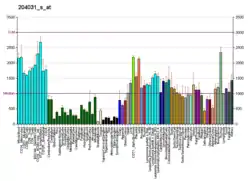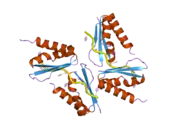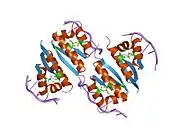PCBP2
Poly(rC)-binding protein 2 is a protein that in humans is encoded by the PCBP2 gene.[5]
Function
The protein encoded by this gene appears to be multifunctional. It along with PCBP-1 and hnRNPK corresponds to the major cellular poly(rC)-binding proteins. It contains three K-homologous (KH) domains which may be involved in RNA binding. This encoded protein together with PCBP-1 also functions as translational coactivators of poliovirus RNA via a sequence-specific interaction with stem-loop IV of the IRES and promote poliovirus RNA replication by binding to its 5'-terminal cloverleaf structure.
It has also been implicated in translational control of the 15-lipoxygenase mRNA, human Papillomavirus type 16 L2 mRNA, and hepatitis A virus RNA. The encoded protein is also suggested to play a part in formation of a sequence-specific alpha-globin mRNP complex which is associated with alpha-globin mRNA stability.
This multiexon structural mRNA is thought to be retrotransposed to generate PCBP-1 intronless gene which has similar functions. This gene and PCBP-1 has paralogues PCBP3 and PCBP4 which is thought to arose as a result of duplication events of entire genes. It also has two processed pseudogenes PCBP2P1 and PCBP2P2. There are presently two alternatively spliced transcript variants described for this gene.[6]
In humans, the PCBP2 gene overlaps with TUC338, a transcribed ultra-conserved element implicated in Hepatocellular carcinoma.[7]
References
- GRCh38: Ensembl release 89: ENSG00000197111 - Ensembl, May 2017
- GRCm38: Ensembl release 89: ENSMUSG00000056851 - Ensembl, May 2017
- "Human PubMed Reference:". National Center for Biotechnology Information, U.S. National Library of Medicine.
- "Mouse PubMed Reference:". National Center for Biotechnology Information, U.S. National Library of Medicine.
- Tommerup N, Leffers H (May 1997). "Assignment of human KH-box-containing genes by in situ hybridization: HNRNPK maps to 9q21.32-q21.33, PCBP1 to 2p12-p13, and PCBP2 to 12q13.12-q13.13, distal to FRA12A". Genomics. 32 (2): 297–8. doi:10.1006/geno.1996.0121. PMID 8833161.
- "Entrez Gene: PCBP2 poly(rC) binding protein 2".
- Braconi C, Valeri N, Kogure T, Gasparini P, Huang N, Nuovo GJ, Terracciano L, Croce CM, Patel T (2011-01-11). "Expression and functional role of a transcribed noncoding RNA with an ultraconserved element in hepatocellular carcinoma". Proceedings of the National Academy of Sciences of the United States of America. 108 (2): 786–91. doi:10.1073/pnas.1011098108. PMC 3021052. PMID 21187392.
- Kim JH, Hahm B, Kim YK, Choi M, Jang SK (May 2000). "Protein-protein interaction among hnRNPs shuttling between nucleus and cytoplasm". J. Mol. Biol. 298 (3): 395–405. doi:10.1006/jmbi.2000.3687. PMID 10772858.
Further reading
- Kiledjian M, Wang X, Liebhaber SA (1995). "Identification of two KH domain proteins in the alpha-globin mRNP stability complex". EMBO J. 14 (17): 4357–64. doi:10.1002/j.1460-2075.1995.tb00110.x. PMC 394520. PMID 7556077.
- Leffers H, Dejgaard K, Celis JE (1995). "Characterisation of two major cellular poly(rC)-binding human proteins, each containing three K-homologous (KH) domains". Eur. J. Biochem. 230 (2): 447–53. doi:10.1111/j.1432-1033.1995.tb20581.x. PMID 7607214.
- Maruyama K, Sugano S (1994). "Oligo-capping: a simple method to replace the cap structure of eukaryotic mRNAs with oligoribonucleotides". Gene. 138 (1–2): 171–4. doi:10.1016/0378-1119(94)90802-8. PMID 8125298.
- Blyn LB, Swiderek KM, Richards O, Stahl DC, Semler BL, Ehrenfeld E (1996). "Poly(rC) binding protein 2 binds to stem-loop IV of the poliovirus RNA 5' noncoding region: identification by automated liquid chromatography-tandem mass spectrometry". Proc. Natl. Acad. Sci. U.S.A. 93 (20): 11115–20. doi:10.1073/pnas.93.20.11115. PMC 38293. PMID 8855318.
- Funke B, Zuleger B, Benavente R, Schuster T, Goller M, Stévenin J, Horak I (1996). "The mouse poly(C)-binding protein exists in multiple isoforms and interacts with several RNA-binding proteins". Nucleic Acids Res. 24 (19): 3821–8. doi:10.1093/nar/24.19.3821. PMC 146158. PMID 8871564.
- Blyn LB, Towner JS, Semler BL, Ehrenfeld E (1997). "Requirement of poly(rC) binding protein 2 for translation of poliovirus RNA". J. Virol. 71 (8): 6243–6. doi:10.1128/JVI.71.8.6243-6246.1997. PMC 191892. PMID 9223526.
- Kiledjian M, DeMaria CT, Brewer G, Novick K (1997). "Identification of AUF1 (heterogeneous nuclear ribonucleoprotein D) as a component of the alpha-globin mRNA stability complex". Mol. Cell. Biol. 17 (8): 4870–6. doi:10.1128/MCB.17.8.4870. PMC 232339. PMID 9234743.
- Suzuki Y, Yoshitomo-Nakagawa K, Maruyama K, Suyama A, Sugano S (1997). "Construction and characterization of a full length-enriched and a 5'-end-enriched cDNA library". Gene. 200 (1–2): 149–56. doi:10.1016/S0378-1119(97)00411-3. PMID 9373149.
- Czyzyk-Krzeska MF, Bendixen AC (1999). "Identification of the poly(C) binding protein in the complex associated with the 3' untranslated region of erythropoietin messenger RNA". Blood. 93 (6): 2111–20. doi:10.1182/blood.V93.6.2111.406k24_2111_2120. PMID 10068686.
- Wang Z, Day N, Trifillis P, Kiledjian M (1999). "An mRNA stability complex functions with poly(A)-binding protein to stabilize mRNA in vitro". Mol. Cell. Biol. 19 (7): 4552–60. doi:10.1128/MCB.19.7.4552. PMC 84253. PMID 10373504.
- Makeyev AV, Chkheidze AN, Liebhaber SA (1999). "A set of highly conserved RNA-binding proteins, alphaCP-1 and alphaCP-2, implicated in mRNA stabilization, are coexpressed from an intronless gene and its intron-containing paralog". J. Biol. Chem. 274 (35): 24849–57. doi:10.1074/jbc.274.35.24849. PMID 10455157.
- Kim JH, Hahm B, Kim YK, Choi M, Jang SK (2000). "Protein-protein interaction among hnRNPs shuttling between nucleus and cytoplasm". J. Mol. Biol. 298 (3): 395–405. doi:10.1006/jmbi.2000.3687. PMID 10772858.
- Makeyev AV, Liebhaber SA (2000). "Identification of two novel mammalian genes establishes a subfamily of KH-domain RNA-binding proteins". Genomics. 67 (3): 301–16. doi:10.1006/geno.2000.6244. PMID 10936052.
- Chang CJ, Luh HW, Wang SH, Lin HJ, Lee SC, Hu ST (2002). "The heterogeneous nuclear ribonucleoprotein K (hnRNP K) interacts with dengue virus core protein". DNA Cell Biol. 20 (9): 569–77. doi:10.1089/104454901317094981. PMID 11747608.
- Yeap BB, Voon DC, Vivian JP, McCulloch RK, Thomson AM, Giles KM, Czyzyk-Krzeska MF, Furneaux H, Wilce MC, Wilce JA, Leedman PJ (2002). "Novel binding of HuR and poly(C)-binding protein to a conserved UC-rich motif within the 3'-untranslated region of the androgen receptor messenger RNA". J. Biol. Chem. 277 (30): 27183–92. doi:10.1074/jbc.M202883200. PMID 12011088.
- Walter BL, Parsley TB, Ehrenfeld E, Semler BL (2002). "Distinct poly(rC) binding protein KH domain determinants for poliovirus translation initiation and viral RNA replication". J. Virol. 76 (23): 12008–22. doi:10.1128/JVI.76.23.12008-12022.2002. PMC 136902. PMID 12414943.
- Abraham RS, Geyer SM, Price-Troska TL, Allmer C, Kyle RA, Gertz MA, Fonseca R (2003). "Immunoglobulin light chain variable (V) region genes influence clinical presentation and outcome in light chain-associated amyloidosis (AL)". Blood. 101 (10): 3801–8. doi:10.1182/blood-2002-09-2707. PMID 12515719.
- Pickering BM, Mitchell SA, Evans JR, Willis AE (2003). "Polypyrimidine tract binding protein and poly r(C) binding protein 1 interact with the BAG-1 IRES and stimulate its activity in vitro and in vivo". Nucleic Acids Res. 31 (2): 639–46. doi:10.1093/nar/gkg146. PMC 140511. PMID 12527772.









